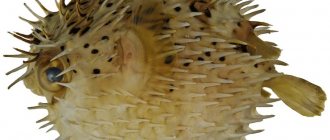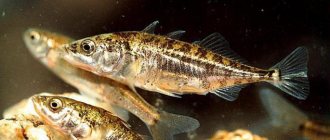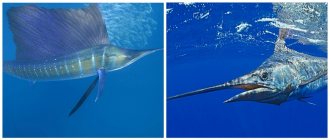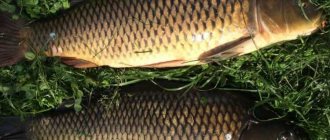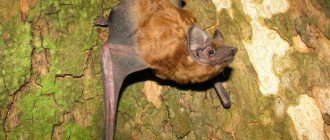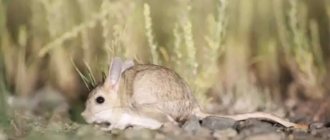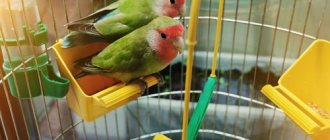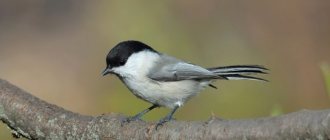It is believed that the most delicious and healthy types of fish are salmon, and among them, sockeye salmon, which is also called krasnitsa or red, stands out in terms of its taste and benefits for humans. This name is justified - the marine inhabitant is indeed the reddest in the color of its flesh, and during spawning it is easy to distinguish it from other species of salmon spawning in Kamchatka and Alaska by its bright and predominant red color. From the article you will learn who the red sockeye salmon is - where it lives, what it eats, what it looks like.
Description
| Class: | Ray-finned fish |
| Squad: | Salmonidae |
| Family: | Salmonidae |
| Genus: | Pacific salmon |
| View: | Red salmon |
| International name: | Oncorhynchus nerka |
Male sockeye salmon at sea (above) and during the spawning period (below)
Sockeye salmon is an interesting fish for both fishermen and cooks. It contains a huge amount of vitamins and minerals, and in doses that are equal to or exceed the daily human requirement. In terms of fishing, sockeye salmon has few competitors among salmon. The fish population is not under threat, it is more accessible to catch, and the insane resistance that it provides while sitting on the hook allows you to recharge with adrenaline and enjoy the feeling of anticipation of serious catch!
What does sockeye salmon look like?
In fact, sockeye salmon is a Pacific salmon that has an appearance characteristic of representatives of its species:
- a hump on the back, noticeably increasing during the spawning period;
- curved upper jaw with large sharp teeth (females have smaller mouths and smaller teeth).
Photo: sockeye salmon appearance
A feature that distinguishes sockeye salmon from other representatives of salmon, including its closest relatives (chum salmon, chinook salmon, pink salmon) is the number of gill rakers. Their number can reach 30, while in other fish it barely reaches 22.
Sockeye salmon during feeding in the ocean
An important distinguishing feature is the rich red color of sockeye salmon meat. This is due to dietary habits.
Sockeye salmon during spawning in rivers and lakes The
scales of sockeye salmon are round, tightly pressed to the body, the mouth is elongated but relatively narrow, the belly is white, the fins are well developed, stand out in a rich dark color, sometimes reaching black. Moreover, the appearance of the fish may differ depending on where it is located - in the sea or in the river.
In the sea
Sockeye salmon spends most of its life at sea. During this period, she gains fat before reproducing. Its scales have a light shade, reaching silver, since the fish has not yet had time to “be saturated” with coloring pigments from its main food source - calanid crustaceans, rich in carotene.
Differences between female and male sockeye salmon of sea and river species
In a river
Before going out to spawn, the fish changes, and males undergo a greater “transformation” than females:
- the hump grows;
- the scales merge with the body;
- the head acquires a greenish tint;
- the body becomes bright red.
It is curious that the spawning of sockeye salmon itself, unlike other salmon, takes place in lakes.
It is interesting that the sockeye salmon that hatch from eggs in lakes with sufficient food do not go to sea, remaining at the place of their birth all their lives, migrating only when there are “local” problems with food, as well as temperature conditions.
feeding
One-year-old juveniles, less often fingerlings, when they grow 7–12 cm long, migrate from rivers and lakes into salty sea waters to feed. The fry swim the entire 48 km journey at night to escape predators. Over the course of four years, they grow and mature, their meat becomes not pink, like all other salmon, but bright red. Sockeye salmon acquires this rich color by feeding on calanid crustaceans. She receives carotene from them, which accumulates in her body.
Yandex pictures
Where does sockeye salmon live?
The “place of residence” of the fish depends on its age.
Newly born fry try not to leave the lake in which they were born. Since during spawning adults choose places for eggs that are rich in food, that is, zooplankton, babies do not have problems with nutrition.
As they grow older, they go out into the rivers, go down to the mouth, and swim into the Pacific Ocean. At the same time, sockeye salmon develop something like “social relationships”:
- fish gather in schools or join existing ones;
- constantly interacts with relatives, massively correcting the movement of the school with the help of sensitive lateral lines;
- searches for places rich in food, collectively, without separating from the school.
Sockeye salmon is a schooling fish, both in the ocean and during spawning.
Until spawning, sockeye salmon is in the sea, then it rises along rivers to spawning grounds - lakes, mainly of volcanic origin.
The fish's range is wide, but most of the population lives permanently along the coast of North America, especially near Alaska and the western coasts of Canada; in rare cases, sockeye salmon is found in the southern Pacific Ocean as far as California.
In Russia, only two large spawning grounds are known - in Kamchatka and on the Kuril Islands, in particular, on Iturup (Lake Krasivoe). In addition, sockeye salmon go to spawn in the lakes of the northern Japanese island of Hokkaido.
What does sockeye salmon eat?
The fish is predatory, but does not attack large prey, preferring to hunt:
- benthic invertebrates;
- crustaceans (favorite delicacy);
- fry of other species.
Moreover, relatively large crustaceans and invertebrates become part of the diet with age.
Newborn fish prefer microzooplankton and do not refuse it throughout their lives.
Salmon are not scavengers, but in the absence of other food sources they do not refuse animal remains on the bottom. If the fish feeds on carrion for a long time, it will lose its culinary value for humans - it will lose its beneficial properties, it will look unattractive, and the color of the meat will fade. Fortunately, this happens very rarely and exclusively in lake conditions.
Natural enemies
The main enemy of sockeye salmon is the bear. The terrestrial predator is dangerous for fish during its maturation period and, mainly, during spawning. When salmon rises along the rivers to their spawning grounds, the clubfooted salmon “stand guard” near the rapids, catching prey from the water and devouring it right on the spot.
It is not known exactly how many fish do not reach the target, but, according to various estimates, about 30% die in the clutches of a clubfoot predator.
Sockeye salmon often becomes prey for bears during spawning
. In addition, the danger is posed by:
For women
Thanks to sulfur, phosphorus and chlorine, as well as B vitamins in fish fillet, aging of the body slows down at the cellular level, skin rejuvenation occurs, and the condition of nails and hair improves.
With the help of potassium, excess fluid is removed from the body, swelling is eliminated, and this is very important during the period of bearing a child. Potassium also has a beneficial effect on the functioning of the heart and blood vessels, improves blood microcirculation, and reduces its viscosity.
Thanks to folic acid, eggs are formed. This is a very important element in the functioning of the organs of the female reproductive system. Improves the course of pregnancy, reduces the risk of developing fetal pathologies and accelerates recovery after childbirth. At the same time, libido and fertility improve.
When breastfeeding, such a fish product promotes the proper growth and development of the baby, saturates its body with micro and macroelements.
Yandex.Pictures
Types of sockeye salmon
Like many other salmon species, sockeye salmon cannot be called “monotonous.” True, there are few species of this fish, and they differ from each other relatively little.
Kamchatka sockeye salmon
The Kamchatka “variant” is practically no different from the sockeye salmon that lives in the waters of Alaska and Canada. the name is due to the geography of its distribution, but, in fact, it is the same species. Moreover, the difference in size between Kamchatka sockeye salmon and the “American” variety is not due to genetic differences, it depends on nutrition and temperature.
Externally, the fish is similar to chum salmon during the marine period of life. It differs from it mainly in the number of gill rakers, as well as in the structure of the fins. They are soft and mobile in sockeye salmon, which leads to the fact that it is difficult to hold such a fish with your hands - there is simply nothing to grab onto. During the spawning period, it differs from chum salmon in its bright red color.
Serebryanka or passable
Sockeye salmon of this variety lives at the place of birth only for the first few months. As it grows, it descends along the rivers to the sea, then forms herds, gains weight for 3-4 years, after which it returns to its native reservoir for spawning, where it dies. It grows up to 60 centimeters, young individuals have a silver color, which, as they consume crustaceans rich in carotene, changes to red.
Kokanee or "residential"
Unlike the silver salmon, this subspecies of sockeye salmon does not leave its native lake; it spends its entire life there, spawns there, and dies there. On average, the fish is smaller than silverfish and is not inferior in taste and nutritional value to the sea “variant”.
Kokanee is a species of sockeye salmon that does not migrate to the ocean. She's not that big.
There may be several reasons why sockeye salmon remain in their native lake:
- technical impossibility of entering the river, for example, due to a blocked riverbed as a result of a natural disaster such as a landslide;
- There is an abundance of food at the spawning ground; the fish simply do not need to swim anywhere to eat normally.
Interestingly, in Japan, some specimens of resident sockeye salmon are used for decorative purposes along with carp and goldfish.
Price range
Sockeye salmon is the most delicious fish of all salmon. But it is expensive and rarely found on the shelves of markets and shops. Average prices in rubles per 1 kg in Moscow:
- Balyk – 1680.
- Fillet with skin – 1211.
- Carcass without head, gutted – 848.
- Tail – 650.
- Slices, 200 g – 450.
Before buying fish, it is advised to make sure that it is sockeye salmon and that it is not rotten:
- The carcass is elastic, there is no sharp fishy smell.
- The meat has a bright red-orange color.
- There are no pieces of ice on the frozen product.
Store fresh fish for 24 hours in the refrigerator on an ice bed or 2 months in the freezer.
Features of reproduction
The process of procreation in salmon is perhaps the most complex in the world of fish. It consists of several stages, including a period of weight gain, social adaptation, “switching on” of the instinct of return and death after spawning.
Sockeye salmon going to spawn
When becomes sexually mature
Since sockeye salmon reproduce once in their life, nature could not come up with reasons for early puberty. With an average lifespan of fish of 4-6 years, regardless of gender and habitat, sexual maturity occurs, respectively, at 4-6 years of age, and salmon immediately begins to experience a craving for the spawning site.
Sockeye salmon spawning
The process is complex, exciting and incredibly important to the ecosystem of the places where it happens. When the time comes for reproduction, that is, towards the end of summer, fish living in the ocean gather in huge schools and rush into rivers, and not just any rivers, but those through which they themselves once went out to sea.
The ascent upstream is difficult and dangerous:
- Predators and poachers lurk at every step;
- you have to overcome rapids;
- a lot of effort is spent, some fish die from exhaustion halfway if they were unable to gain enough weight during their life in the ocean.
Upon arrival at the place, that is, in a lake connected by a river to the sea, the females look for suitable places for laying eggs (where there is no direct access to predators and there is a fair amount of zooplankton), making something like nests at the bottom (sometimes more than 20). Next, eggs are laid, and a male immediately appears nearby, fertilizing the eggs with milt.
For the female, life ends here; she dies almost immediately. Technically – from complete exhaustion, in fact – in order to provide the fry with food. The male is just beginning his main function - for several months he zealously protects the eggs from predators. Moreover, during this period it becomes extremely aggressive and can even attack a bear that steps into the water next to the nest.
The fry are born at the beginning of winter, by this time the male is exhausted to the limit and dies. Thanks to the death of their parents, babies are provided with food for several months:
- they eat bottom plankton accumulated on decaying fish bodies;
- in some cases, they themselves do not refuse carrion.
As the sockeye salmon grows, it will move further and further from its place of birth, but after a few years it will return to the same lake to give birth to a new generation of salmon.
Hormonal changes during the spawning period lead to irreversible changes in the fish’s body
Maximum weight and size of sockeye salmon
By the standards of a river fish, sockeye salmon is quite large - adult individuals reach 60-80 centimeters in length, gaining weight of 2-3 kilograms, in some cases up to 6-8. Stories about fishermen encountering specimens weighing half a centner are urban legends that have nothing to do with the truth.
How long does he live?
5-6 years. In captivity it can live up to 8 years of age.
Laying eggs
After schools of fish reach the spawning site, they break up into separate pairs and begin arranging birth nests.
- Couples choose fast sections of the river in shallow water with a pebble bottom and clear water.
- The female takes on the entire burden of construction work. She lies on her side, vigorously beats her tail, removing silt from the bottom, then makes a semicircular depression in the ground about 30 cm deep. At this time, the males jealously guard their chosen ones from other males.
- The fish lays eggs in the prepared nest, which the males immediately fertilize. The masonry is covered with a layer of sand and pebbles on top.
- One pair makes from three to five clutches for a total number of eggs of up to 4 thousand pieces. The process takes from three to five days.
- Many females remain guarding the nests until their end and soon die from exhaustion. Tormented and exhausted after a long journey, the males also die in the river. They are carried far from the nests by the fast current, belly up and tail forward.
- A sad fate awaits all fish that come to spawn. According to scientists, this was invented by nature itself. Decomposition products accumulating in the river are necessary for the development of planktonic organisms, which in turn serve as a source of food for fry.
Population and species status
Sockeye salmon is not an endangered species, but there is such a threat in the future due to:
• widespread poaching, short-sighted and barbaric; • climate change - warming will inevitably reduce the population size and increase the population of some natural enemies, including some species of seals.
There are two large stocks of sockeye salmon known in the World Ocean - the largest lives off the coast of North America, and the second, smaller one, lives near the Russian Far East and Japan.
Amateur sockeye salmon fishing
Fishermen value sockeye salmon for its ability to offer serious resistance when fishing, as well as its abundance - there are no obstacles to catching even during the spawning period. Fish can be caught equally well with spinning and float rods; the fishing technique is the same as with chum salmon (with the only difference being that sockeye salmon is much smaller).
The peculiarity is that a decent share of fishing occurs in lakes, therefore, amateur anglers need to adapt to calm water conditions. Otherwise, “hunting” for this species is no different from catching any other Pacific salmon.
Metamorphoses
When moving to the river mouth, and this happens during high tide, inevitable processes are launched in the sockeye salmon’s body:
- A fish with silvery scales suddenly changes its body color and turns red (hence the name “redfish”).
- In males, the head and fins darken to a greenish tint, and a hump appears on the back.
- The jaw extends and already resembles a beak with teeth.
By all indications, it becomes clear that the sockeye salmon is slowly dying, but it is trying its best to get to its spawning ground, where it was born.
Pixabay.com
Interesting Facts
- Warm water is detrimental to sockeye salmon not only due to loss of activity. The fact is that if the temperature of the habitat exceeds +2 degrees Celsius, then the lateral line of the fish begins to lose sensitivity - this reduces the salmon’s ability to avoid meeting dangerous sea predators.
- More than half of the sockeye salmon caught worldwide is salted. Moreover, this is relevant both for fishing and for amateur fishermen.
- There are known cases of sockeye salmon going to spawn attacking people. The fish is unable to cause serious injuries, but it’s still not pleasant enough.
- Despite the fact that fry sometimes feed on the remains of their dead mother, cannibalism is unusual for sockeye salmon. They go there only as a last resort, when there is a catastrophic shortage of food.
- African peoples know red fish, but do not consider it a delicacy. For some reason, they do not understand its taste, considering it not very pleasant.
Male and female sockeye salmon
Meaning for humans
Before the ban on industrial fishing, 3-4 month old pups were massacred because of their white fur. Now the seal is an object of ecological tourism, a guarantor of the sustainability and purity of the largest reservoir of fresh water reserves. Two nerpentariums offer an opportunity to admire these animals and appreciate their intelligence and resourcefulness.
The first was formed in 1998 in the village of Listvyanka, the second was founded six years later in Irkutsk. Project manager E. Baranov is confident that the Baikal seal is not inferior in intelligence to dolphins, and during demonstration performances it demonstrates ingenuity and artistry.
To observe animals in their natural environment, you will have to travel. As part of an excursion group or on your own by boat, visit the protected area of Lake Baikal on the Ushkany Islands, the coast of Ayaya Buta or Olkhon Island, where the favorite rookeries of pinnipeds are located.
Today, according to sociological surveys, the Baikal seal is one of the ten wild animals that tourists want to see.
Chemical composition and calorie content of sockeye salmon
Sockeye salmon meat is rich in vitamins, and their amount exceeds the daily requirement for an adult:
- B12 – 7.82 mcg per 100 g of product (260% of the norm);
- D – 11 µg (110%);
- PP – 9.5 mcg (48%).
Other vitamins are also present, but in lower concentrations, which is still very beneficial for people.
In addition to vitamins, sockeye salmon is rich in chemical elements necessary for normal human metabolism - cobalt, phosphorus, chlorine, potassium, chlorine, selenium, iodine, chromium.
The calorie content of the product is estimated at 142 kcal per 100 lightly salted meat.
Beneficial features
Krasnitsa contains easily digestible proteins and carbohydrates by the body with a relatively high fat content if the fish is caught during the spawning period. Low calorie content makes sockeye salmon a dietary dish, especially if it is cooked baked. Polyunsaturated fatty acids are involved in the formation of cell membranes, which contributes to skin rejuvenation, which is necessary to maintain beauty at any age.
Contraindications for use
The only risk that sockeye salmon may pose is a deterioration in health in people suffering from hypervitaminosis. However, even such patients can consume this meat in moderation, the main thing is to know when to stop.
In other cases, sockeye salmon is completely harmless, with the exception of an incorrectly prepared dish from a spoiled product, as well as a severe allergy to fish as such.
There is a myth that sockeye salmon caught off the coast of Japan is radioactive - a blatant lie, research has not revealed anything like that!
For men
Meat contains a large amount of useful substances. The most beneficial for males are zinc and selenium. These microelements have a beneficial effect on the functions of the organs of the reproductive system, activate cell synthesis, and improve blood circulation in the pelvic organs. This is a good prevention of the development of prostate inflammation and prostate adenoma. Also, such substances improve quantitative and qualitative blood parameters.
The high fat content of kokanee and a large amount of protein in the composition contributes to the rapid gain of muscle mass. Therefore, it is recommended to use it for those who work out in the gym and dream of an ideal figure. This product increases libido, improves erection, and is a natural aphrodisiac, like other red fish.
In parallel, positive properties include improving the immune system and preventing thyroid diseases. Thanks to this product, hormonal levels return to normal.
Sockeye salmon meat in cooking
Sockeye salmon is considered a delicacy fish; its high benefits and harm, which are insignificant for the human body, are appreciated everywhere. It is loved all over the world except in some regions, which is why there are a great variety of dishes made from it. Delicious meat is easy to process; even an inexperienced amateur cook can handle it.
What does sockeye salmon taste like?
Thanks to the abundance of fatty acids (at the same time, the meat is dietary), sockeye salmon meat has a delicate structure - it melts in the mouth, and this is not a metaphor. In taste, it practically does not differ from other salmon breeds; in terms of this “characteristic” it is closest to chum salmon.
